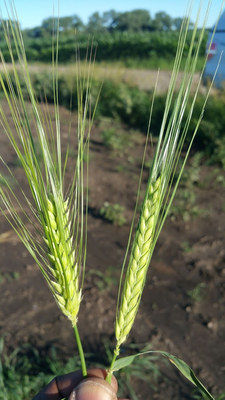Sulfur Improved Grain Yields of Malting Barley (Tradition and ND Genesis)
Rationale
Farmers are faced with steep premium deductions if barley produced for malt has protein levels that are high, usually greater than 13%. Farmers therefore have to keep N rates high enough to maximize yields, but low enough not to enhance protein above thresholds susceptible to premium deductions. Sulfur is applied to barley to enhance yields, but it is anecdotally believed by a few producers that application of sulfur causes their grain protein to increase.
Objectives
- To examine how sulfur (S) fertilization affects barley yield and grain protein
- To verify whether two common barley varieties differ in their response to S
Method
- Varieties grown: ND Genesis (2-row variety) and Tradition (6-row variety) shown in Figure 1.
- Sulfur treatments: 0, 10, 20, 30 lbs S/ac (applied and incorporated as ammonium sulfate)
- The effects of these S rates were evaluated at three N rates (30, 60, 90 lbs/ac), to examine if grain response would be different for the different soil N levels
- Soil N at planting was 39 lbs/ac. Soil test results for S is not reported because it is not reliable.

Figure 1. Heads of 6-row (Tradition, left) and 2-row (ND Genesis, right) barley.
Results
- Sulfur significantly improved grain yields (Figure 2). On average, yields improved by 4 bushels due to S
- Grain protein was not affected by S
- Yields of the two varieties were not different (about 86 bushels each on average)
- Grain protein was significantly less for ND Genesis (11.28%) than for Tradition (13.02%). Note that for malting barley, low grain protein at about 11 to 12% is of better quality than at 13% or above
- Yields were not different between 30, 60, or 90 lbs N. Total N removed with the grain (averaged between 60 and 90 lbs N rates) ranged from 110 lbs at 0 lbs S, to 115 lbs N removed at 30 lbs S.
Observations
- Sulfur did not affect grain protein. A possible reason is that, if more N is taken up because of applied S, the additional N is probably going towards yield improvement rather than towards protein
- Consider applying 10 pounds of S as a sulfate or thiosulfate form before or at seeding
- Sulfur is recommended for barley because it has potential to improve yields. Several conditions could limit S availability, and therefore would warrant fertilization. These conditions include high clay and sandy soils, soils with high soil organic matter, pre-season normal to high snowfall or rainfall, etc. More information is available on fertilizing malting and feed barley by Dr. D. Franzen and Dr. R. Jay Goos at: (https://www.ag.ndsu.edu/publications/crops/fertilizing-malting-and-feed-barley#section-8)
Jasper M. Teboh, Ph. D.
jasper.teboh@ndsu.edu
Research Soil Scientist


